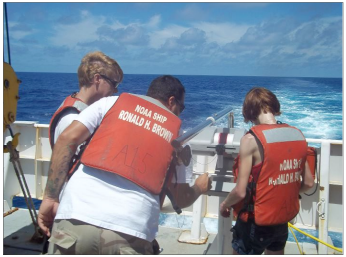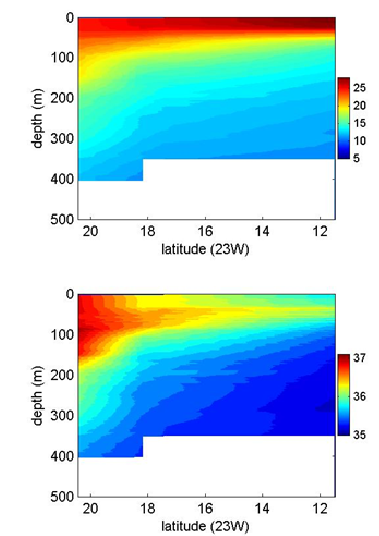AOML Tests New Technology for The Collection of Underway Oceanographic Data
Researchers at the Physical Oceanography Division at AOML are testing a new observational platform for measuring the upper ocean thermal and salinity structure. This new observational platform named UCT Depth (UCTD) will enable researchers to collect temperature and salinity profiles of the upper ocean at underway speeds, to depths of up to 500 m.

Figure 1. A group in the Physical Oceanography Division formed by Gustavo Goni, Rick Lumpkin, Marlos Goes, Verena Hormann, and Grant Rawson is leading the effort to assess the value of the UCTD for climate-related studies and its potential implementation at AOML as a source of sustained observations of the upper ocean.
The first tests were performed aboard the NOAA ship Ronald H. Brown during the July-August Pirate Northest Extension (PNE) cruise on 2011. During that cruise AOML researchers teamed with a group of Oceanscience in order to evaluate the UCTD system making approximately 60 casts. The data obtained revealed the subsurface salinity maximum associated with subsurface mid latitude surface water subducted beneath fresher water that had earlier in the year been exposed to rainfall associated with the Intertropical Convergence Zone (Figure 2).

Figure 2. Temperature (top) and salinity (bottom) sections collected by the UCTD while transiting southward in the Atlantic Ocean along 23°W from 20.5°N to 11.5°N.
AOML is now providing specific recommendations to Oceanscience based on the experiences collected during the PNE cruise in order to update the system before another AOML test is conducted. This type of system will ultimately be capable of robust, nearcontinuous measurements of the upper ocean while underway, saving ship time and funds, as it can replace a subset of the more time consuming standard CTD stations when the upper 500 m is of primary scientific interest.